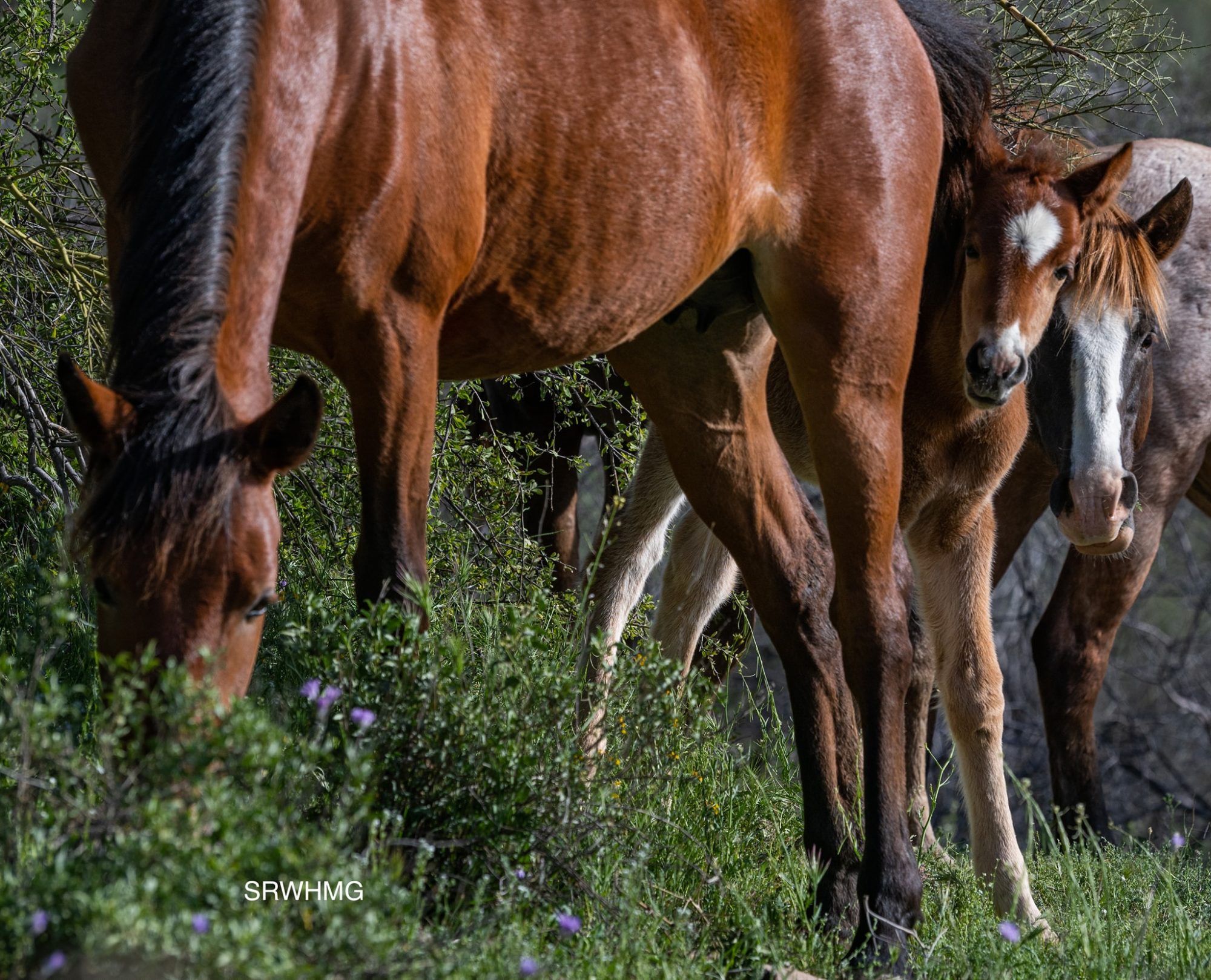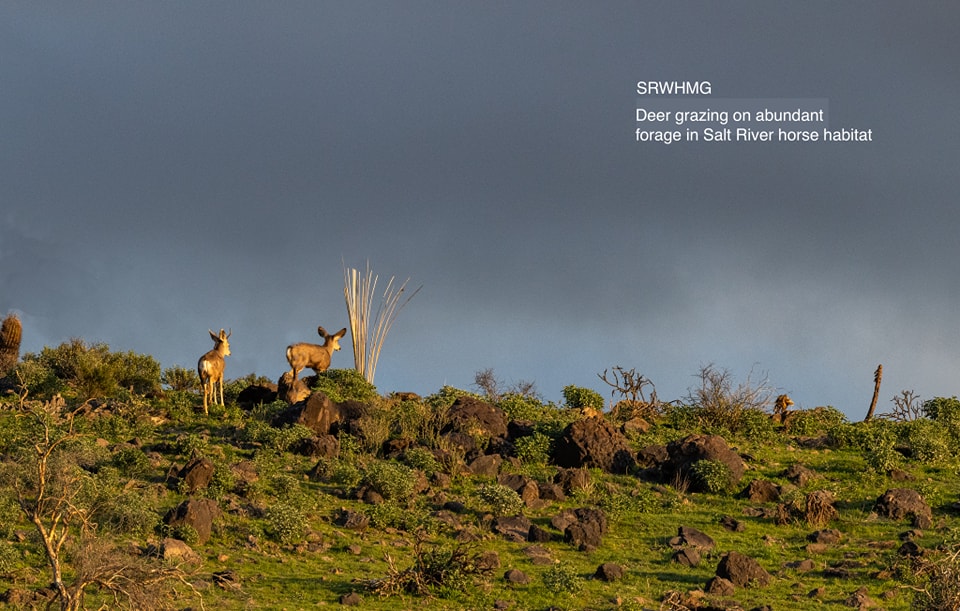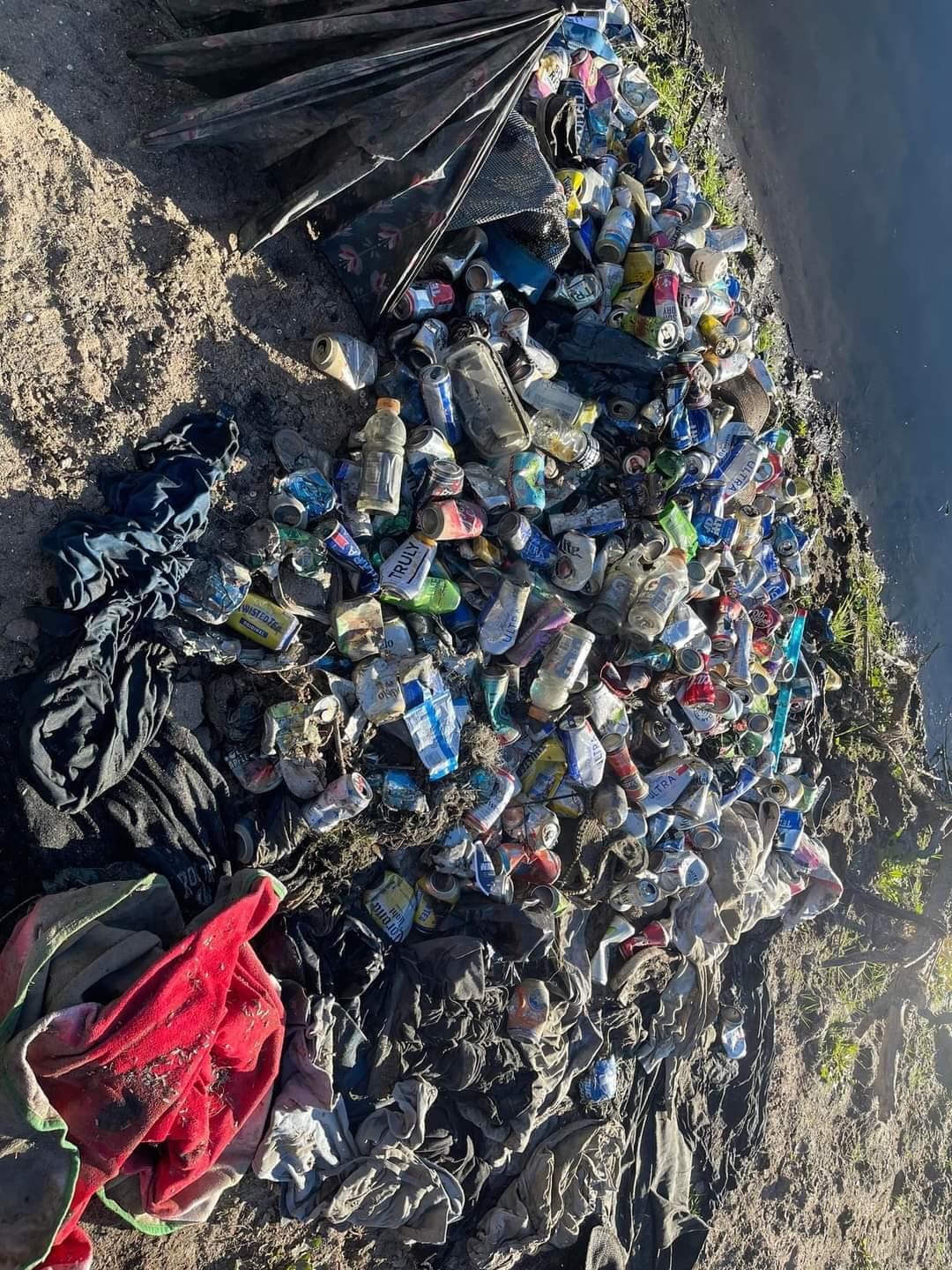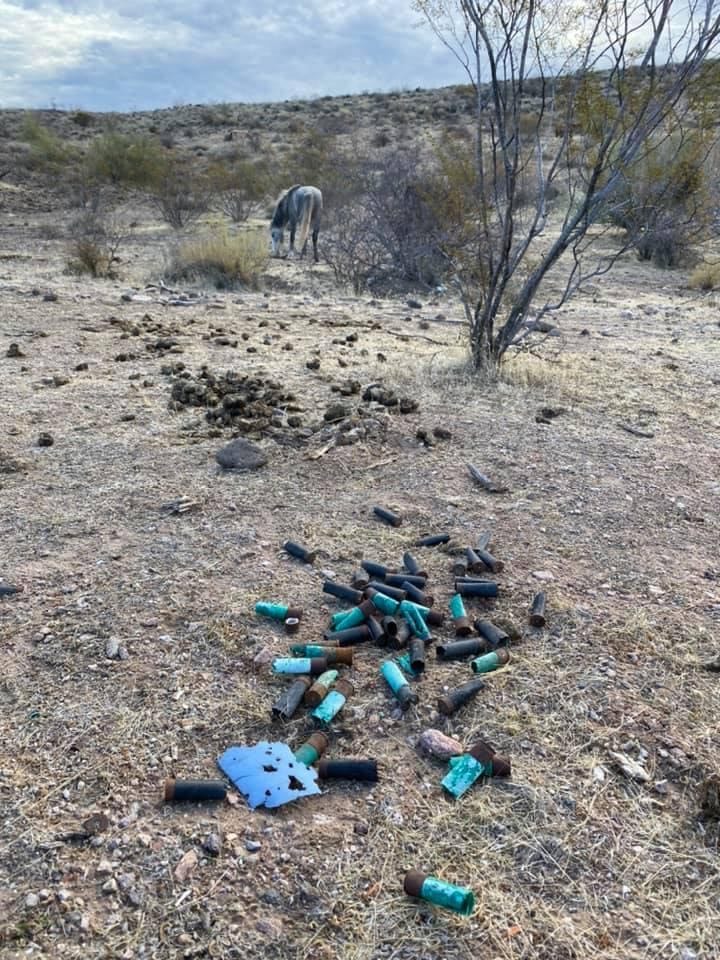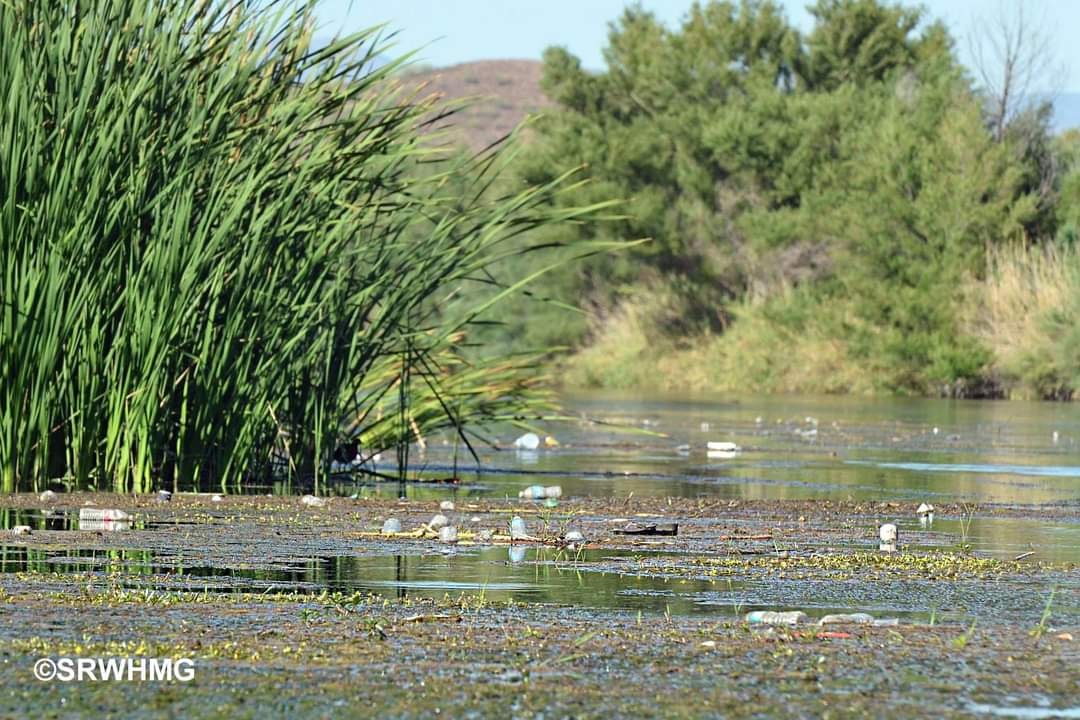
📰 Breaking: Beloved Salt River horse herd in great jeopardy, again! Lawsuit seeks to halt their humane management.
Salt River, April 29th 2023
Enjoyed by millions of visitors to the Tonto National Forest, the Salt River wild horses roam freely in their 20,000 acre habitat along the river, protected by State Law ARS 3-1491. They are the pride of the community, a favorite subject of photographers and the icon of the wild, free spirit of Arizona and the American West.
The only new foal to the herd was born in March and was just named “Splendor” by the public. It is the humane birth control program that has reduced the foaling rate of the herd from 100 foals a year, to just one or two per year, so that the herd can stay in balance with it’s environment.
With this huge success of the program, implemented by SRWHMG, Arizona is setting the example for humane management of wild horses.
However, it seems that success is always challenged. The management program and the necessary intergovernmental agreements, are now under attack. This is an outrage because the public of Arizona has already fought hard for the protection of this famous and historic horse herd.
The Center for Biological Diversity has filed a lawsuit against the Forest Service that seeks to overturn the will of the Arizona people and halt the intergovernmental agreements, which would result in overpopulation and subsequently, their removal and demise.
The lawsuit by the CBD makes many claims that are 100% false, and contains no scientific proof of any kind to back the allegations in it.
To start, the CBD falsely alleges that there are 600 Salt River horses. However, they base their lawsuit on the Long Term Management plan, which clearly states were approximately 450 horses at the time of it’s writing. However that number is already substantially lower at 414 horses at the current time. These 414 horses are recorded in a database that contains a record of every single horse that has ever been on the Tonto National Forest. At the present time approximately 100 of these wild horses reside on the adjoining reservations, making the exact total count only 314 horses in the Tonto National Forest. An official fly-over helicopter count by the AZDA and BLM in 2022, logged just 270 horses in 2022. Approximately 150 are currently roaming near and around the Salt River habitat the complaint refers to, and the other 150 roam the northern mountainous region and are not dependent on the river for water.
The complaint also purposely omits the fact that the number of foals in this herd is only one or two per year. The population numbers are declining, because of the successful fertility control program by the 3rd party contractor, the Salt River Wild Horse Management Group. (SRWHMG.)
Furthermore, the CBD falsely alleges that the long term management plan aims to lower the population to 200 over 25-35 years. This is 100% false. The long term management plan sets a population goal of 100-200 horses reached within the next 10 years. The lawsuit is therefore based on a 100% false allegation.
The relief the lawsuit seeks is the halt of the fertility control program. It may be obvious that this would cause a boom in population, which would then cause more environmental concerns, not less. What is the motive behind encouraging a boom in population if the goal is to protect the environment? This is the big question, and the answer is that they are aiming to make the situation so unsustainable, that there will need to be a removal of the horses.
Even more falsehoods include claims that these horses eat cottonwood trees, which they do not, and no such evidence exists. Therefore fingers cannot be pointed to horses for cottonwood decline, if there is any at all. However, the last few years of long lasting drought and SRP low water management of only 8 CFS in the Salt River is hard on all trees along the river, especially water-dependent trees like cottonwoods. In addition, the recent high floods have washed away some saplings, but otherwise cottonwood can be seen doing good along the river.
Furthermore, the suing parties offer no proof of declining numbers of any of the species mentioned in the lawsuit. In fact all species along the river are living symbiotically together including the horses, who are protected by ARS 3-1491 from slaughter and killing.
Bighorn sheep are being seen again along the lower salt river with babies, bald eagle populations are thriving and deer are seen grazing the abundantly green hills alongside the horses.
In fact, the only population that is declining is the horse population.
It should not be omitted that horses also have many positive impacts on their environment, such as manure that contains live seeds of trees, which at the same time provides a great fertilization bed until the trees are established. Most of the trees in the forest have sprouted from horse manure, which helps all other species, especially birds. However, of course the lawsuit does not mention any positive impacts the horses have, as it aims for their removal.
A huge detrimental threat to all species of the lower Salt River is the extreme wildfire danger. With great rainfall this year, there is going to be extreme fire danger with high fuel loads of dried up vegetation. The horses help reduce that fire danger significantly, by consuming the dry brush under the trees, which is the fuel to forest fires. Wildfires would obviously be to the detriment of all existing species on the lower Salt River, regardless of if they are protected by the state or by the endangered species act. This huge value of wild horses may be the very reason the riparian area frequented by the horses, has been spared from destruction in past forest fires.
And there are even more easily found facts omitted by the Center for Biological Diversity:
The Tonto National Forest is visited by 8 million people per year, which does cause severe problems with pollution and degradation of the lower Salt River. Thousands of tubers and kayakers, ATV’s, horseback riders and especially the over hunting of birds and mammals, impact all animals negatively, including the protected species.
During the hunting season shots ring loudly all day in and around the Salt River. Extreme amounts of hunting trash and bullets litter the floor of the forest and even illegal hunting activities like snares have been found around horse hooves, causing necessary intervention and rescue of horse Neiman in 2020.
The Forest Service is managing one of the most difficult and highest visited forests in the nation and because of their concern for the environment and consideration for public opinion, they have made responsible and sustainable agreements, which are to their discretion, and are not applicable to NEPA requirements.
Out of over abundant concern for the environment, steps have even been taken to mitigate any damage the horses might cause, while the reduction of the herd occurs over time; Water troughs have been strategically placed away from the riparian area, which encourage them to use the entire 20,000 acres as opposed to concentrating around the riparian area. The Forest Service has also placed boundary fencing between the reservations and fencing along the roads so that they don’t escape their 20,000 acre habitat.
The long term management plan is a responsible management plan, in line with protecting the environment, inline with State statute, inline with the Forest Service Nepa requirements and inline with the will of the public. The lawsuit, which seeks to terminate the successful management programs and “do nothing instead”, is frivolous.
Simone Netherlands, president of the Salt River Wild Horse Management Group states; “If the environmental concern was genuine, they would not attempt to halt a successful birth control program, as that would produce a larger and uncontrolled population of horses. Once the population is out of control, then the horses will be removed. It will be far better to stay the course of humanely managing the horses, and all organizations and the Forest Service should work hard together to reduce and mitigate environmental damage and pollution of the lower Salt River”.
SRWHMG is vowing to join the lawsuit and defend the horses. Simone Netherlands is available for comment along the Salt River by appointment. 928 925 7212, Simone@respect4horses.com

